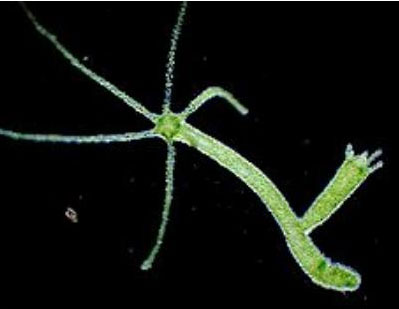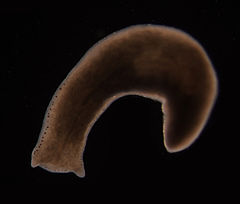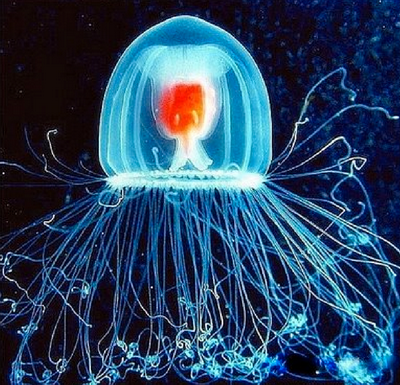I’m pretty sure you viewers must have gotten happy on seeing the word ‘immortality’. All of us don’t want to die, right? Sadly, we have to, also, the topic on which I’m talking about, ‘Biological immortality’, only applies for other special animals, not us humans. Why not us? Is there a way we can ‘revive’ after death? All the questions will be answered on this amazing article on this amaaaazing topic!
To start with, biological immortality is a state in which cells don’t die from aging, better termed with a scientific term ‘senescence’. This state is achieved by the cells of the organism when it has reached the maximum life span, after which it turns to its youth state.
But, as God doesn’t like someone living forever, he created this mechanism in such a way that the biologically immortal being may not die from senescence, but can still die from injury or disease. Smart, these Gods are. But anyways, we can avoid injury and disease to some extent, but we cannot avoid aging, right? That’s prevented in this mechanism. So, you’re kind of ‘immortal’.
This definition of immortality has been challenged in the new Handbook of the Biology of Aging, because the increase in rate of mortality as a function of chronological age may be negligible at extremely old ages, an idea referred to as the late-life mortality plateau(Don’t get confused. Even I got confused and never deciphered the meaning in it). The rate of mortality may cease to increase in old age, but in most cases that rate is typically very high. As a hypothetical example, there is only a 50% chance of a human surviving another year at age 110 or greater. This term, ‘immortality’ is also used to describe cells which are not subject to Hayflick limit(Sorry for the new words, deal with it). Hayflick limit is the limit at which cell division doesn’t take place because the DNA can no longer be reduced.
Anyways, there are some lucky animals who have this mechanism, and scientists have also tried to bring that immortality to human beings too, using some techniques we will be talking about.
1. Bacteria and some species of yeast
Feeling to oppose me when you see the heading? Well, yes, you can surely say that bacteria and other unicellular organisms age, as time passes, they divide more slowly and die. But, this is in case of asymmetrical(Daughter cells are not equal) division of bacteria, where the parent buds asymmetrically and the parent ages, but the youth is restored to the daughter cells. But, when parents symmetrically splits or buds into two daughter cells, youth is restored to the parent cell. Going by this speculation, gametes and stem cells are regarded ‘immortal’ too, because they divide symmetrically by the process of meiosis.
2. Hydra
This is one of the most studied bio-immortal organism as it doesn’t even undergo senescence, and scientists are most likely concerned of its regenerative ability, which is so awesome. You must have seen this type of ability in the Deadpool, where his body parts regenerate when cut, of course with an exception to his head. But, this amazing organism can regenerate any tissue or cell of it, and it doesn’t age or die of old age. And guess what, its death from infections is very, very rare. Can’t believe right? The hydra’s outer covering has a protein called the hydramycin, which acts as a anti-microbe system and no bacteria or virus can enter it. Then, the only thing on earth which can kill it is diseases, which is also rare in ocean bed. Oh, my god. I want to be a hydra now. Below is a electron microscopic of hydra. Relish it!

3. Lobsters
Lobsters are considered bio-immortal because its amazing ability of turning more fertile as they age. Researches have found out that older lobsters are more fertile than younger ones. Sadly, this does not make them ‘immortal’ in our traditional sense as they are bound to die after a shell moult the older they get. This is because as they molt at a older age, the shell is more larger, hence they molt more. Molting(by the way, molting is the shedding of the older shell so that the new shell is stronger) requires enormous amount of energy, and as they molt more, they exhaust and eventually die of fatigue. Some lobsters may not even molt, but if they do not molt, the shell will eventually become damaged, infected with many nasty microbes, and they die. Maybe, immortal to scientists, but not immortal to us! Anyways, let’s see a picture of a sad lobster who is bound to die next year.

4. Planarian flatworms
These little pods have both asexually and also sexually reproducing types, and like hydra, it has the ability to regenerate indefinitely. The asexually-reproducing ones have indefinite regenerative capacity, which is given by the adult stem cells of the flatworms. Scientists are also trying to transfer genes of it to people so that people can regenerate like it does, but wait, it has still not been successful and also of course it will take the countries’ whole economy whilst buying it for the whole country. Anyways, get thrilled while watching this pic of the planarian pods.

And finally, the most anticipated animal to be immortal…
5. Jellyfish
Don’t quit! Jellyfish can reveal some unravelling features than you think! And, the specific species of the jellyfish I’m gonna talk about is Turritopsis nutricula, now changed to Turritopsis dohrnii, due to categorical reasons. This amazing jellyfish is one of the known amazing cases of animals, capable of reverting back to a sexually immature after attaining puberty. When it is sexually immature, it’s called the polyp. Those who attained puberty, are called medusae(Not the medusa in Percy Jackson books or Greek mythology). When this jellyfish is subject to physical stress, or is sick or old, it can convert back to its polyp state, when it is not harmed. It’s crazy, and it is more like going back in time through biology. Anyways, this process of conversion of the jellyfish to its polyp form is called transdifferentiation, which is a pretty long word, but very rapid process.
Though they have this remarkable ability, they can still die from succumbing to a disease during the medusa stage, which is rare in oceans. But, they can also die from being eaten when it is still in its larval stage. But, its ‘super mothers’ are adapted in such a way that it can electrify its intruders who try to take its baby! Here’s the electrifying picture of the awesome jellyfish:

Transdifferentiation of these immortal jellyfish has inspired scientists to find stem cells using this process so that it can potentially engineer humans to be ‘immortal’. Fast, scientists. We don’t have all years to live!
That’s not all guys! You have some share as well!
That’s all about these amazing animals. That’s not all, and not fair that only these animals are gifted with these prodigious ability. We have ways to regenerate, and also some ways to not age too! But, as these techniques are still on hold whether they are safe, they are rarely used. Anyways, let’s move on!
1. Cryonics or cryopreservation of humans
You will freak out reading this! Have you ever thought of humans who have long died and can be revived back?! Yes, but that’s all dreams, you think?. But, cryonics is the preservation humans under very low temperatures. This revives the damaged cells of the brain and other somatic cells and the person within 50 to 100 years, can be revived. But, this has received hesitation from the people, as it is not a part of the normal medical practice and also that reviving the human being has no use if his families and friends are already dead. But, scientists have assured that while cryonics is being developed in the future, the technology will be more advanced to make the procedure more suited. I’m totally with cryopreservation. Are you? Reveal in the comments!
2. Gene therapy
The is a therapy which is very uneconomical at the present, and also it’s a long term therapy which can last up to an year or two. But the cost, and the long term treatment is overshadowed by the sensational effects of this therapy. Using this therapy, you can return back to your young age, though maybe you can only return 10 years or 15 years back. But, 15 years does make a lot of difference, especially to women, who want to stay young always. This therapy has been tested by a women, who treated herself using this therapy. And this therapy not even halted her aging, but also reversed the age process, hence taking her ‘back in time’. Especially useful for people who are still alive…cryonics is useful for dead ones.
So, that’s the end of this amaazing topic guys. Viewers of this post who are young, you are all lucky, because we get to experience the future, especially of Cryonics or even gene therapy. So, for more news, stay alive and connected!
-Science geek


Really awesome. But could have avoided the usage of scientific terms more or could have explained it better. I personally think this topic aroused my curiosity and am gonna do much more research. Thanks.
LikeLiked by 1 person
Thanks, Pavan. But, at this age, you have to deal with it. But, anyways thanks for your valuable feedback. Hope to see more!
LikeLiked by 1 person
Yeah, I agree but all of your viewers wont know the technical terms
LikeLiked by 1 person
For the viewers, in the brackets, I’ve made it convenient for them so that I type the actual meaning of it. So, viewers who come here basically have to have some basics about science or english.
LikeLiked by 1 person
See my next post on the states of matter!
LikeLike
oi Shreyas you have not sent me an author’s request
LikeLiked by 1 person
Dudes you guys are funny and this was important and also nice i was actually researching about this for your marriage.I actually found out a restaurant of owmein chow mein.😉😉😉😉😉😉😉
LikeLike
Please dont reply
LikeLike
Really interesting information .Please also provide the info on reference articles
LikeLike
Thanks for your feedback, ma’am. I will try to provide the info as soon as possible!
LikeLike
Great work on the HIV article.
LikeLike
Thank you for your feedback!
LikeLike
Telomeric ends of the DNA also contribute to aging . shortening of the telomeric ends is one of many reasons, for ageing.
Any mechanism on that can prevent its shortening can slow down the process of aging .
“amazing job on aging “
LikeLike
Thank you for your add-ons! And yeah, if I had written about the teloremic ends of DNA, it would have been more complicated. But, thanks for the add on!
LikeLike
Great blog with great info
Thankful that I visited it.
Just as a suggestion,can you upload more of physics content
LikeLike
Thanks for your valuable feedback, Bhargav! I will soon update with more of physics content!
LikeLike
Awesome information… I liked it a lot. Good job, Shreyas and Vijay.
LikeLike
Thanks Vishwa for commenting! Hope to see more of your appreciative comments!
LikeLike